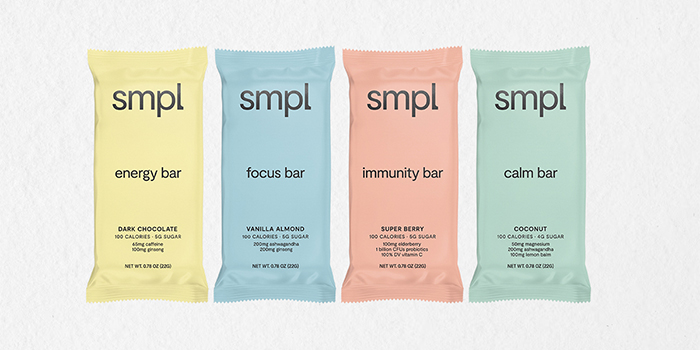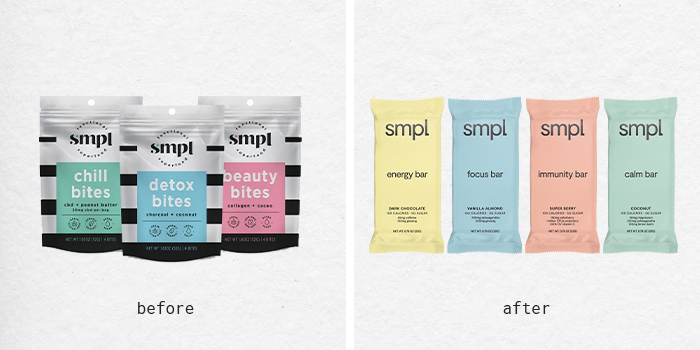Functional Snack Maker SMPL to Relaunch With Bar Line

When the onset of COVID-19 forced the majority of its independent retail partners to temporarily shut their doors last year, functional snack maker SMPL used the lull as an opportunity to rethink its product, ultimately discontinuing its line of bites at the end of 2020. Now, the brand is relaunching this month with a new bar line, fresh look, and the confidence it can now reach more consumers with a more approachable and affordable product line.
Set to debut on the brand’s website on October 19, the new bar line features four varieties, each with different functional benefits and ingredients: Energy (caffeine), Focus (ashwagandha and ginseng), Immunity (elderberry, probiotics and vitamin C) and Calm (magnesium, ashwagandha and lemon balm). The bars are sold for $30 per 12-pack, or $24 for those with a subscription.
To support the launch, the company recently completed a $1.1 million funding round which will be used for production and marketing over the next year, Fried said. Investors include Aurify Brands co-founders Andy Stern and John Rigos, Super Angel Fund, irrvrntVC, Visionary Music Group founder Chris Zarou and Colin Darretta, co-founder of superfood gummy brand Grummies. SMPL previously raised $100,000 from The Zell Founders Fund, a student-led venture fund at the University of Michigan’s Zell Lurie Institute for Entrepreneurial Studies.
Launched in 2018, New York-based SMPL’s functional bites previously were offered in varieties such as Chill (CBD), Detox (charcoal) and Beauty (collagen), and were sold in locations such as juice bars, fitness studios and over 250 independent and specialty grocers.
Bars were originally slated to be the brand’s second line, but the pandemic gave the brand the time to take a more introspective approach and “make some bigger decisions” with its first product line. Ultimately, Fried said, the brand decided it could not support two different lines at this time, and the bars offered a wider reach in terms of price, health attributes and functionality.
According to Fried, consumer research showed that bars offer a more familiar format for consumers than bites. Furthermore, a large swath of its target consumers — largely millennial females — wanted less sugar and fewer calories, and the bars were able to be formulated to reduce both by 60%.
The new format also solves several logistical issues. On the retail side, buyers were unsure where to merchandise the bites in-store, adding an “extra layer of friction” for the startup. Manufacturing the bites was also much more difficult, Fried said and the bar format has allowed the company to switch over to a new manufacturer that is better equipped to help the brand scale up production. As a result of the new production methods, the company has also been able to lower product pricing from $6 to $7 for 1.8 oz. four-pack of bites to $2.50 per bar.

The bars are also more clear about their active and functional ingredients, Fried noted, listing exact dosages included on front of pack. With its bites, he said there was often confusion on use occasions based on the names and ingredients. Now, product names like “Energy” and “Focus” help to more clearly demonstrate functionality, especially for those who may not be familiar with adaptogens or nootropics. The new packaging is also “stripped down,” emphasizing the “simplicity of what we’re trying to achieve within the wellness category,” he added.
“To reduce that confusion as much as possible is what we’re looking for, especially bringing these ingredients into the snack category. I think that’s already a challenge,” Fried said. “So reducing any other challenges like familiar product format, from the bites to the bars, or reducing confusion around times of day, if we can do that we can successfully bring these ingredients into the snack category.”
Looking ahead to the rest of the year, before pushing into grocery, the company will focus on direct-to-consumer sales and adding placements in quick service restaurants like vegan chain Little Beet as well as alternative channels like hotels, Fried said. Its main focus will be connecting with its consumers directly, primarily through a text message-based concierge service that allows consumers to ask questions about the product and manage their subscription.
“That’s where we see the biggest opportunity to really own our customers, and go directly to them and really create a robust, full-stack marketing approach to get to know them and build long term relationships with them,” he said. “And those relationships are more COVID proof than going to a third party through retail.”
Explore the Nombase CPG Database
Head to Nombase to learn more about the tagged companies and their offerings.


















